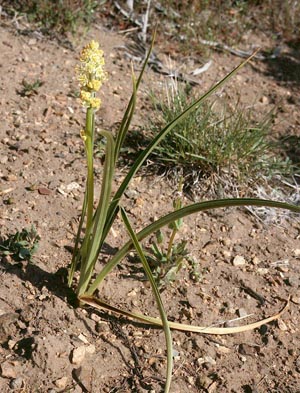Foothill Deathcamas

Common Name(s):
Foothill Deathcamas
Deathcamas
Scientific Name:
Zigadenus paniculatus (Nutt.) S. Wats.
Scientific Name Synonyms:
Helonias paniculatus Nutt.
Symbol:
ZIPA2
Description:
Life Span: Perennial
Origin: Native
Season: Cool
Growth Characteristics: A forb growing 1 to 2 feet tall, with an underground scaly bulb. The bulbs lack an onion odor. Growth begins very early in the spring, before most other pants. It is most abundant in foothill areas. It generally flowers April to July, depending on elevation. Reproduction is by seed.
Flowers/Inflorescence: It has white to yellowish flowers that are borne on the stem in terminal panicles in early summer. The flowers have orange stamens that give them a soft, lacy quality.
Fruits/Seeds: Rough brown seeds are formed in a 3-celled capsule, which is especially poisonous.
Leaves: Plants have 5 or 6 basal, thickened, V-creased leaves with a grass-like appearance.
Ecological Adaptions:
Deathcamas is found from the semidesert to mountain climatic zones.
Soils: It is found in a wide range of soils. It is most abundant in sandy loam and gravelly or stony soils.
Associated Species: Big sagebrush, low larkspur, and sandberg bluegrass.
Uses and Management:
All parts of this plant contain a poisonous alkaloid at all growth stages. Sheep and cattle often eat Deathcamas in early spring before other plants start producing forage. Sheep are the most commonly poisoned, but cattle deaths have also been reported. Respiratory problems occur in sheep after eating ½ to 2 pounds of deathcamas. Signs of poisoning include: Salivation, nausea and vomiting, weakness, coma, and death within a few hours to 2 days. Pastures containing deathcamas should not be grazed until late spring when other forage is available. The bulbs, which can be mistaken for onions or sego lily, can cause severe illness in humans.

